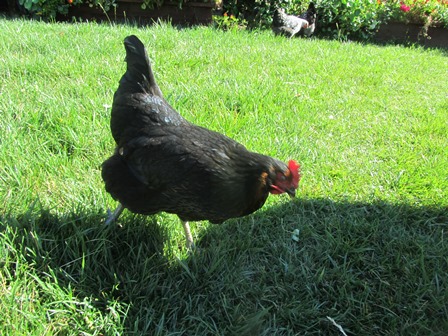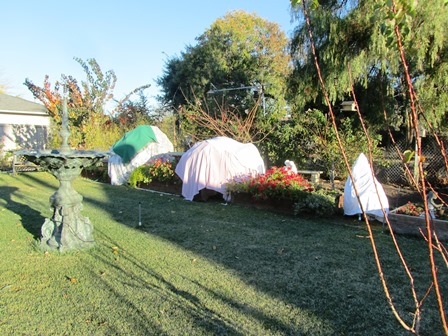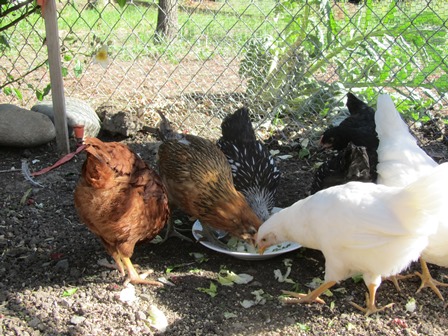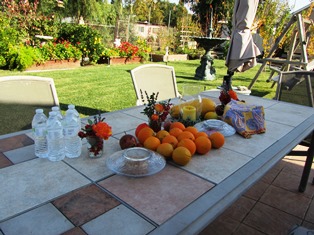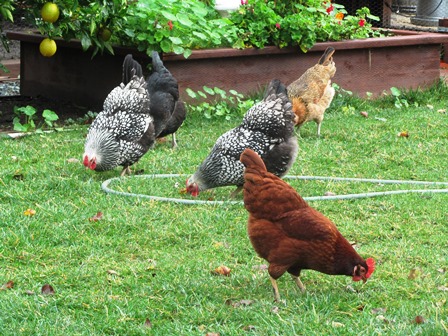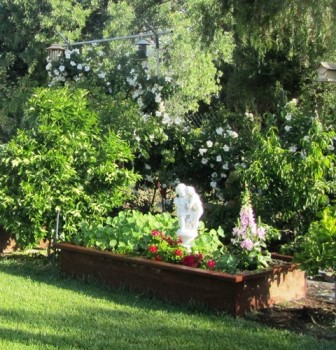Eggs Don’t Get Fresher Than This!
The chickens were making a ruckus this morning just after sunup. They often do that when one of them is occupying a favorite nesting box and another wants in. Finally, I got up and trudged out to the chicken house.
When I let the chickens out of their house into their run today, one of them–the Black Sex Link hen (Blacky)–hadn’t quite finished laying her egg.
But as they always do, the hens made a run for it when the door opened. Blacky included. They hopped out and followed the Rhode Island Red in the pursuit of grass and worms and other things chickens like to eat. That’s when I noticed Blacky waddling along, trailing the other hens. That’s unusual for her.
It soon became clear why. She had a fully formed brown egg halfway out. I’ve seen some strange things since raising these hens from when they were baby chicks housed in a big tub in my kitchen. But this was the strangest.
I reached down to see about giving the egg a bit of pull when Blacky decided to push. I caught the egg before it hit the ground.
* * *
If you enjoy reading about gardening, keeping bees, raising chickens, and creating delicious recipes, you might want to check out my novels from Kensington Publishing.
The Henny Penny Farmette series of cozy mysteries are available online and in tradition bookstores everywhere, in hardcover, kindle, and mass market paperback formats.
The MURDER OF A QUEEN BEE will be released in hardcover October 1.
A Prowling Raccoon Looking for a Warm Chicken Dinner
My farmette looks like some kind of ghostly haunt after sunset. That’s because of all the bed linen I’ve draped over citrus trees and frost-sensitive plants. On moonless nights, the backyard looks like a gathering of ghosts illuminated by the warming lamp in hanging in the hen house.
That heat lamp splays light across the back of the property. I didn’t realize right away that the claw marks in the dirt near the chicken run are from a large raccoon who, thanks to the light, now knows exactly where to find the chickens and has come prowling over the last few nights. My locks and the buried wire fencing of the chicken run are keeping the hens safe.
For the last few mornings, the water in the Italian fountain (the motor is turned off now) has been frozen and doesn’t thaw until mid-morning. Still, I see wild birds bathing in it. And we have plenty of wild birds now, thanks to twenty pounds of bird seed we’ve poured into feeders around the property.
I’m looking forward to the weather changing again in a couple of days–rain is on the way. The last storm brought a new blooms to the roses and caused the daffodils and some summer tulips to push up green shoots.
Since some of my trees perform better with a good winter chilling, I feel obliged to appreciate the cold. Besides, I can stay inside and bake, read books and seed catalogs, and write on my third cozy mystery novel.
If you enjoy reading about farmette life, you might like the farmette milieu featured in A Beeline to Murder, the first book in my Henny Penny Farmette series of cozy mysteries. See, http://tinyurl.com/p8d6owd
Protecting Your Backyard Flock in a Heat Wave
I lost a chicken this morning despite taking measures to protect her from the deadly heat wave we’ve been having here in the Bay Area. The last thing someone attached to their hens ever wants to see is one of her precious little girls gone. Mine was a Silver Laced Wyandotte (who leaves behind a sister) and five other hens with whom she was raised.
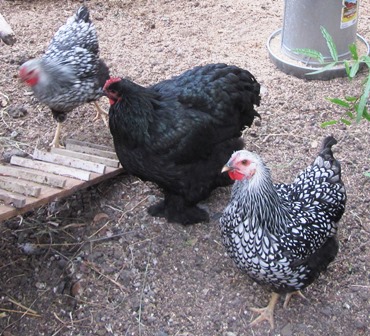
The Silver Laced Wyandotte (black-and-white) hen in the foreground succumbed to the extreme heat sometime during the night
Our farmette sits in the east bay hills and too far inland from the San Francisco Bay or the delta (which flows to Sacramento) to gain much benefit from cooling breezes off the ocean. We’ve had triple digit temps on the farmette for days.
I put out extra water basins for my chickens, kept their doors open in the chicken house at night (there is a wire run with a wire ceiling to protect them when they’d rather roost outside), and fed them frozen corn, cool seedless watermelon treats, and chilled grapes.
The chicken house has windows that I keep open (they have reinforced wire over the screens). I reduced the amount of litter on the floor (I use ground corn cob) since it could hold the heat.
I haven’t install a fogging system or fans, but I might if this heat keeps up.
The only telltale sign that my hen was in trouble was that she seemed to exhibit lethargy and to have lost weight (although it was difficult to tell under all her feathers).
Her comb had turned slightly pale and seemed to have shrunk in the last 24 hours. When I check on her last night she was turning herself to face the wall. Not a good sign since, in my experience, I’ve seen chickens do this before they pass away.
Some strategies for helping backyard chickens survive extreme heat include the following tips.
Eight Strategies to Help Chickens Beat the Heat
1. Make sure windows of chicken houses face north to south to allow breezes to blow through, rather than face east to west (rising and setting sun).
2. Keep litter on the chicken house floor low (1 to 2 inches is sufficient).
3. Position your chicken house under a tree, if possible, where the structure receives shade.
4. Make certain you have several watering dispensers (placed in the shade) with clean, fresh water every day during hot weather.
5. Add ice cubes to the watering canisters.
6. Put out treats such as bowls of frozen corn and cool, seedless watermelon, and chilled grapes or blueberries.
7. Use a fan, if necessary to remove heat from the chicken house.
8. As an emergency measure for a chicken that looks distressed, dip her in cool water.
Consider This Before You Get Backyard Chickens
My bedroom window faces the back of our property where the chicken coop sits. Every morning, I’m awakened by repeated grauwkkkk sounds made by the Silver Laced Wyandottes and the Rhode Island Red hens, the noisiest ones of all my chickens.
I wish I’d read up more on the breeds before making my selections at the feed store. I love keeping chickens and the eggs are fabulous. That said, there are some of the areas I wish I’d known more about. I might have chosen different breeds.
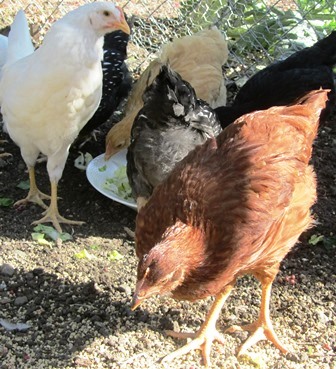
Rhode Island Red hen seems to be at the top of the pecking order in this small flock of backyard chickens
1. Noisemakers–some breeds are noisier than others. I seldom hear the occasional cluck from my White Leghorns, but the Wyandottes never seem to shut up. Get a bunch of hens together and conversing, and you’ll soon see what I mean.
2. Snacking–chickens love snacks but give them judiciously. If they consume too many treats like blueberries, fresh corn from the cob, and bits of bread or rice, the quality of their eggs may suffer. But as soon as you give them treats, they become your best friends and will follow you around.
3. Pecking–chickens quickly establish a pecking order; they will also peck you . . . some harder and more aggressively than others. My Black Sex Link hen just seems kind of mean and pecks with impatience. But the Rhode Island Red will give an almost loving peck that’s not hard and doesn’t hurt.
4. Broodiness–when a hen goes broody (like my Wyandotte and Buff Orpington hens), her hormones have told her she needs to sit on a clutch of eggs until they hatch (about three weeks). But if you do not have a rooster to have fertilized those eggs, the hen will sit on them anyway, tying up a nesting box and hoarding eggs that will have to be tossed out when she finally figures out that she’s engaged in a futile pursuit of baby chicks. Some breeds tend to broodiness more than others.
5. Water and Food–chickens need water, love crumble, and can benefit from a serving of cracked grains and dried worms. To ensure their egg shells are sufficiently rigid, they may also need additional oyster shell calcium. And like all living beings they need fresh water. If they go without water, they can stop laying for weeks. I’ve figured out the cracked grains must be so tasty they are like cotton candy and after them, the hens don’t want their good food.
6. Diminishing Returns–hens begin laying when they are about five months old. After the first year, egg production will fall off about 20 percent in subsequent years. They generally lay eggs for seven or eight years, but can live to be older and produce no eggs.
7. Egg size–when a hen tries to lay too large of an egg, it can cause a condition called cloaca prolapse. It can claim her life–I’ve lost two chickens to this problem. One was an Ameraucana heritage chicken that laid blue-green eggs. I do miss her as she was skittish but quiet.
8. Moving Hens or a Rooster–if you are getting the gift of a chicken from a neighbor or friend, move that chicken into the flock at night. When he or she wakes up in the morning, the whole event will be a fait accompli and will generate less stress for all involved.
Farmette Chores, the Writing Discipline, and Landscapes
Each day on my farmette starts with chores involving plants and animals . . . and writing. The latter might seem a bit strange until you understand that my farmette–with its organic heirloom vegetables, eggs, and honey–has evolved into a brand that includes my forthcoming Henny Penny Farmette novels. It’s business. I have to write three novels in three years. I’ve already written two.
Like any business that involves regular tasks for keeping the enterprise thriving, my farmette novels require a daily commitment to writing. Excellence in my writing endeavors is just as important to me as the quality of my Henny Penny Farmette jams, honey, eggs, and this blog.
I rise early, at 4:00 AM, to get a jump on my day. The roosters start crowing around that hour, but the sleepy hens remain on the roost until daylight. I like to stroll outside, see the edges of the black sky turning lighter at the eastern horizon, observe the position of the moon and stars, feel the cool predawn air on my face, and notice the silent vapor of fog receding like gray shroud being tugged upon.
I enjoy the scent of pine and orange blossoms (when the trees are in bloom), and take note of the occasional spritzing of a skunk or cat marking its territory while out prowling. These observations become notes in my journal.
At bedtime and when I awaken during the night, I practice yoga nidra, a state of deep relaxation and lucid dreaming. Often, though, the lucidity may be nudged aside as sleep and dreams in which I am not aware of my physical environment take over. Still, I sometimes work through problems in my life or my stories and awaken with a solution . . . sometimes, but not always.
During the morning hours before sunrise, following a good night’s sleep, I feel sharpest and most in tune with nature and my deepest, inner Self. One of my favorite writers John O’Donohue observed the profound and numinous presence of nature and wrote in his book Anam Cara: “Landscape is not all external, some has crept inside the soul. Human presence is infused with landscape.”
The Henny Penny Farmette landscape has echoes from the past in it. I’ve re-created my grandmother’s farm garden where I spent happy hours of my childhood. But also, I’ve got my own personal stamp on this landscape. It’s a lot of work, but I embrace the daily chores and the discipline needed to keep the farmette and a book series going. It’s an ongoing journey to a new horizon.
 Facebook
Facebook Goodreads
Goodreads LinkedIn
LinkedIn Meera Lester
Meera Lester Twitter
Twitter




